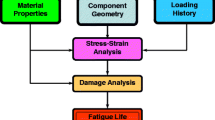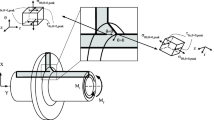Abstract
Fatigue design rules for welds in the ASME Boiler and Pressure Vessel Code are based on the use of Fatigue Strength Reduction Factors (FSRF) against a Code-specified fatigue design curve generated from smooth base metal specimens without the presence of welds. Similarly, Stress Intensification Factors (SIF) that are used in the ASME B31 Piping Codes are based on component S-N curves with a reference fatigue strength based on straight pipe girth welds. Typically, the determination of either the FSRF or SIF requires extensive fatigue testing to take into account the stress concentration effects associated with various types of component geometry, weld configuration, and loading conditions. As the fatigue behaviour of welded joints is being better understood, it has been generally accepted that the difference in fatigue lives from one type of weld to another is dominated by the difference in stress concentration. However, general finite element procedures are currently not available for effective determination of such stress concentration effects. This is mainly due to the fact that the stress solutions at a notch (e.g., at weld toe) are strongly influenced by mesh size at and near a weld, resulting from notch stress singularity. In this paper, a mesh-insensitive structural stress method is used to re-evaluate the S-N test data. Its applications in consistently representing the stress concentration effects on fatigue S-N data for pipe girth welds are demonstrated. A single master S-N approach is presented by means of a mesh-insensitive structural stress parameter formulated within the context of fracture mechanics. The major findings are as follows: (a) The mesh-insensitive structural stress method provides a simple and effective mean for characterising stress concentrations at vessel and pipe welds (b) The structural stress based parameter provides an effective measure of stress intensity at welds, which can be related to fatigue lives. (c) Once the mesh-insensitive structural stress is used, the S-N data processed thus far can be reasonably consolidated into one narrow band. Therefore, single master S-N curve for vessel and piping welds can now be established, regardless of piping weld types or geometries (straight pipe girth welds, different types of flange welds, elbow welds, mitre bends, etc.), and can be used to general a master fatigue design curve.
Similar content being viewed by others
References
Barsom, J.M. and Vecchio, R.S., “Fatigue of Welded Structures”, Welding Research Council Bulletin 422, June 1997.
ASME Section XI Task Group on Fatigue Operating Plants, “Metal Fatigue in Operating Nuclear Power Plants”, Welding Research Council Bulletin 376, November 1992.
ASME Criteria of the ASME Boiler and Pressure Vessel Code for Design by Analysis in Sections III and VIII, Division 2, American Society of Mechanical Engineers, 1969.
ASME Boiler and Pressure Vessel code, Section III, Rules for Construction of Nuclear Power Plant Components, NB, Class 1 Components and section VIII, Rules for Construction of Pressure Vessels, Division 2 — Alternate Rules, American Society of Mechanical Engineers, 1997.
Jaske, C.E., “Interpretive Review of Weld Fatigue-Strength -Reduction Factors”, Report No. 1 in Fatigue Strength Reduction and Stress Concentration Factors for Welds in Pressure Vessels and Piping, Welding Research Council Bulletin 432, June 1998.
Hechmer, J.L. and Kuhn, E.J., III, “Fatigue-Strength-Reduction-Factors for Welds Based on NDE”, Report No. 2, in Fatigue Strength Reduction and Stress Concentration Factors for Welds in Pressure Vessels and Piping, Welding Research Council Bulletin 432, June 1998.
Markl, A.R.C., “Fatigue Testing of Piping Components”, Trans. ASME, Vol. 74, pp. 287–303, April 1952.
Dong, P. and Brust, F.W, “Welding Residual Stresses and Effects on Fracture in Pressure Vessel and Piping Components: A Millennium Review and Beyond”, The Millennium Issue, ASME Transactions Journal of Pressure Vessel Technology, Vol. 122, No. 3, August, pp. 329–328, 2000.
Dong, P., Zhang, J., and Hong, J.K., “Structural Stress Analysis Procedures”, US and International Patent Applications, November 2000.
Dong, P., “A Structural Stress Definition and Numerical Implementation for Fatigue Analysis of Welded Joints”, International Journal of Fatigue, 23, pp. 865–876, 2001.
Dong, P., Hong, J.K., and Cao, Z., “A Mesh-Insensitive Structural Stress Procedure for Fatigue Evaluation of Welded Structures”, International Institute of Welding, IIW Doc. XIII-1902-01/XV-1089–01, July 2001.
Dong, P., and Hong, J.K., “Fatigue of Pressure Vessel and Piping Welds: ASME’s FSRF Rules Revisited”, submitted for publication in ASME Transactions Journal of Pressure Vessel Technology, 2003.
Markl, A.R.C. and George, H.H., “Fatigue Tests on Flanged Assemblies”, Trans. ASME, Vol. 72, pp. 77–87, 1950.
Markl, A.R.C., “Fatigue Tests of Welding Elbows and Comparable Double -Mitre Bends”, Trans. ASME, Vol. 69, pp. 869–879, November 1947.
Heald, J.D. and Kiss, E., “Low Cycle Fatigue of Nuclear Pipe Components”, Journal of Pressure Vessel Technology, Vol. 96, pp. 171–176, August 1974.
Scavuzzo, R.J., Srivatsan, T.S., and Lam, P.C., “Fatigue of Butt-Welded Pipe”, Report 1 in Fatigue of Butt-Welded Pipe and Effect of Testing Methods, Welding Research Council Bulletin 433, July 1998.
Rodabaugh, E.C. and Scavuzzo, R.J., “Effect of Testing Methods on Stress Intensification Factors”, Report 2 in Fatigue of Butt-Welded Pipe and Effect of Testing Methods, Welding Research Council Bulletin 433, July 1998.
“Stress Determination for Fatigue Analysis of Welded Components”, IIS/IIW 1221–93, Abington Publishing, Abington Cambridge, 1993.
“Fatigue Verification of Welded Joints”, European Pressure Vessel Code, prEN 13445–3: 1998.
Dong, P., Hong, J.K., Osage, D.A., and Prager, M., “Master S-N Curve Method for Fatigue Evaluation of Welded Components”, Welding Research Council Bulletin 474, Welding Research Council, August 2002.
Macfarlane, D.S., “Fatigue Strength of Gusseted Pipe Bends”, British Welding Journal, Vol. 9, pp. 659–669, December 1962.
Maddox, S. J., “Assessing the Significance of Flaws in Welds Subjected to Fatigue”, Welding Journal Research Supplement, Vol. 52, No. 9, pp. 401s–409s, 1974.
Author information
Authors and Affiliations
Rights and permissions
About this article
Cite this article
Dong, P., Hong, J.K., Osage, D. et al. Assessment of Asme’s Fsrf Rules for Vessel and Piping Welds using a New Structural Stress Method. Weld World 47, 31–43 (2003). https://doi.org/10.1007/BF03266376
Published:
Issue Date:
DOI: https://doi.org/10.1007/BF03266376




